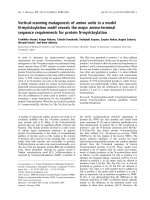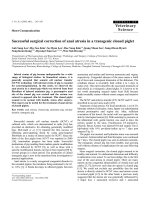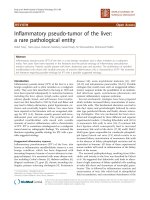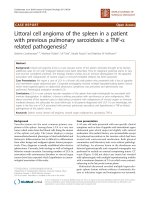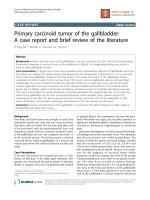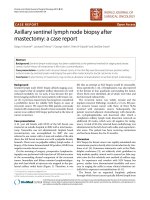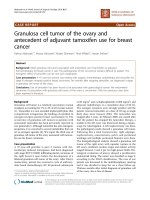báo cáo khoa học: " Typical carcinoid tumor of the larynx in a woman: a case report" potx
Bạn đang xem bản rút gọn của tài liệu. Xem và tải ngay bản đầy đủ của tài liệu tại đây (586.21 KB, 4 trang )
CAS E REP O R T Open Access
Typical carcinoid tumor of the larynx in a woman:
a case report
Fatma Tülin Kayhan
*
, Efser Gürer Başaran
Abstract
Introduction: Neuroendocrine tumors are the second most common neoplasms of the larynx. Histopathologically,
neuroendocrine tumors can be classified into four types: typical carcinoid tumors, atypical carcinoid tumors, small
cell neuroendocrine tumors and paragangliomas. Typical carcinoid tumor of the larynx is a particularly rare
occurrence. We present a case of this rare disease, and review and discuss its diagnosis and treatment.
Case presentation: A 55-year-old Turkish woman presented with a two-year history of persistent hoarseness.
Endoscopic laryngeal examination and computed tomography revealed a supraglottic mass. Direct laryngoscopy
was performed and a biopsy taken. Results of the histopathologic examination and immunohistochemical analysis
were consistent with typical carcinoid tumor of the larynx. A supraglottic laryngectomy was performed. There was
no recurrence during a follow-up period of three years.
Conclusion: Carcinoid tumors require an accurate diagnosis because of their varied clinical behavior and
prognosis. A correct pathologic diagnosis is essential, differentiating the tumors from other neuroendocrine
neoplasms and medullary cancer of the thyroid gland. Immunohistochemical analysis is supplementary to a
standard histopathologic evaluation. Currently, conservative surgical resection without elective neck dissection is
the recommended treatmen t for typical carcinoid tumor of the larynx. Additional cases and case series with long-
term follow-up will be useful for understanding the nature of this tumor and should clarify the prognosis.
Introduction
Neuroendocrine tumors of the larynx are the second
most common neoplasm of the larynx after squamous
cell carcinomas. Four types of neuroendocrine tumor
have been identified by the World Health Organization
(WHO): typical carcinoid tumor, atypical carcinoid
tumor, small-cell neuroendocrine carcinoma and para-
ganglioma [1-3]. Carcinoid tumors and small cell neu-
roendocrine tumors originate from epithelium, whereas
paragangliomas origina te from neural tissue. Typical
carcinoid tumors are less common than other neuroen-
docrine tumors of the larynx, with approximately
20 cases reported in the English language literature to
date [4]. We pres ent an unusual case of typica l carcinoid
tumor of the larynx in a woman, and review the literature
on neuroendocrine neoplasms of the larynx.
Case report
A 55-year-old Turkish woman presented with a two-
year history of hoarseness. She did not use tobacco or
alcohol, and other than a three-year history of diabetes
mellitus, her medical history was unremarkable. Her
family history was non-contributory.
On endoscopic laryngeal examination, a supraglottic
mass was seen, involving the laryngeal surface of the
epiglottis and medial aspect of the pyriform sinus.
Mobility of the vocal cords was normal. Examination of
the neck found no palpable lymphadenopathy. No other
abnormalities were found during the remainder of the
otorhinolaryngological examination, or the general phy-
sical and pulmonary examinations. The results of
laboratory tests were normal, including complete blood
count, Westergren erythrocyte sedimentation rate,
glucose level and electrolytes.
Cervical computed tomography (CT) showed a supra-
glottic mass extending from the right aspect of the med-
ial glossoepiglottic fold to the right ar yepiglottic fold and
pyriform sinus, with involvement of the parapharyngeal
* Correspondence:
Bakırköy Dr. Sadi Konuk Training and Research Hospital, Department of
Otolaryngology, Istanbul, Turkey
Kayhan and Başaran Journal of Medical Case Reports 2010, 4:321
/>JOURNAL OF MEDICAL
CASE REPORTS
© 2010 Kayhan and Başşaran; lice nsee BioMed Central Ltd. This is an Open Access article distributed under the terms of the Creative
Commons Attribution License (http ://creativecommons.org/licenses/by/2.0), which permits unrestricted use, distribution, and
reproduction in any medium, provided the original work is properly cited.
fat tissue (Figure 1). No lymphadenopathy was seen on
cervical CT. Thoracic and abdominal CT revealed no
metastases or synchronous lesions.
Direct suspension laryngoscopy was performed under
general anesthesia. A laryngeal mass with a smooth surface
was seen. Multi ple punch biopsies w ere taken from the
mass, and histopathologic examination was performed.
The tissues were stained with hematoxylin and eosin and
evaluated by light microscopy. Pathological examination of
the biopsy showed tumor infiltration, with trabeculae and
small nests of round eosinophilic cells with uniform
hyperchromatic nuclei, displaying a ‘salt and pepper’ chro-
matin pattern. There was no marked pleomorphism or
necrosis (Figure 2 and Figure 3). The cells were strongly
immunopositive for neuron-specific enolase, chromogra-
nin (Figure 4), synaptophysin and pancytokeratin. Light
microscopy and immunohistochemical analysis revealed
typical carcinoid tumor of the larynx.
A supraglottic horizontal laryngectomy with a tra-
cheotomy was performed. The histopathologic diagnosis
was not changed postoperatively, and the surgical mar-
gins were tumor-free. There were no intraoperative or
postoperative complications. The tracheotomy was
closed in the second postoperative week. Postopera-
tively, the patient did not receive radiation therapy or
chemotherapy. There was no recurrence during a fol-
low-up period of three years.
Discussion
Four different types of neuroendocrine tumor of the lar-
ynx have been identified by the WHO: typical carcinoid
tumor, atypical carcinoid tumor, small-cell neuroendo-
crine tumor and paraganglioma [2,3,5].
A definite diagnosis can only be made histopathologi-
cally. An accurate histologic diagnosis is essential
because the treatment and prognosis depend on the
type of neuroendocrine tumor [2].
Typical carcinoid tumor in the larynx is very uncom-
mon. This tumor type represents 0.5% to 1% of all epithe-
lial neoplasms, and is the least common neuroendocrine
tumor of the larynx. To our knowledge, the case
presented here is only the 20
th
reported in the English
language literature [5,6].
There is a slight male preponderance for this tumor,
with a male to female ratio of 3:1 [2,5]. Typically,
patients with this tumor are in the sixth to eighth dec-
ade of life, and are smokers [2,5,6]. Unusually, our
Figure 1 Computed tomography with intravenous contrast
showed a supraglottic mass.
Figure 3 Uniform round cells with salt and pepper chromatin
without nucleoli, mitoses, or pleomorphism (hematoxylin and
eosin, original magnification ×400).
Figure 2 The lamina propria contained a tumor consisting of
small trabeculae and small nests of round cells (hematoxylin
and eosin, original magnification ×100).
Kayhan and Başaran Journal of Medical Case Reports 2010, 4:321
/>Page 2 of 4
patient was a woman in her fifties, who did not have a
history of smoking, dysphagia or odynophagia [2,5]. She
had only hoarseness as a symptom, and endoscopic
examination revealed a supragl ottic mass with a sm ooth
surface. A typical carcinoid tumor generally grows sub-
mucosally, and is seen as a polypoid or sessile mass [5].
Neuroendocrine tumors of the larynx are located in the
supraglottis because the supraglottic area contains abun-
dant neuroendocrine cells [5].
The diagnostic investigation should include indirect
fiberoptic laryngoscopy, which will show a submucosal
mass in the supraglottic larynx. CT of the larynx should
be used to determine local and regional tumor spread [2].
The diagnosis is made histopathologically; it may be
difficult to distingui sh between typical and atypical car-
cinoid tumor using light microscopy. Typical carcinoid
tumor is comprised of oval o r round cells with uniform
hyperchromatic nuclei, but without significant pleo-
morphism [2]. The cytoplasm is scant and contains eosi-
nophilic inclusions [2]. Scattered, infrequent mitoses and
hyaline stroma are seen [2]. Angiolymphatic invasion,
pleomorphism and necrosis are not seen in typical carci-
noid tumor [5-7].
Intense immunoreactivity for neuron-specific enolase,
chromogranin A, synaptophysin and cytokeratin are the
criteria for a histologic diagnosis [5]. The neuroendo-
crine neoplasms of the larynx contain neurosecretory
components, and can cause paraneoplastic syndrome;
however, this condition is rare [5].
The prognosis of typical carcinoid tumor is good. It
should be treated using conservative surgery [2,5-7]. If
the tumor is extensive and lymphatic metastasis has
occurred, a total laryngectomy and elective neck dissec-
tion should be performed [2,5,7]. Typical carcinoid
tumors are radioresistant [2,4]. Radiotherapy and che-
motherapy are recommended for advanced cases. We
performed only a supraglottic laryngectomy because the
tumor was localized to the supraglottic area and there
was no lymphatic metastasis.
Atypical carcinoid tumors of the larynx are more
common and more aggressive than other neuroendo-
crine tumors of the larynx [1]. The clinical findings and
location of atypical carcinoid tumors are similar to
those of typical carcinoid tumors. A history of smoking
is common. Histopathologically, pleomorphism, nuclear
atypia, necrosis and vascular invasion are found in atypi-
cal carcinoid tumor. The prognosis of atypical carcinoid
tumor is poorer than that of typical carcinoid tumor,
with a 5-year survival rate of approximately 50% [1].
Ext ended surgical resection and elective neck dissection
are proposed treatment options [1]. Radiotherapy and
chemotherapy can be added to surgical treatment [1].
Small cell neuroendocrine neoplasm of the larynx has
an extremely poor prognosis, with five-year survival rate s
of 5% [1]. Generally, cervical and distant metastases are
seen at the time of diagnosis. Surgical tre atment is not
indicated, and chemotherapy and radiotherapy are the
mainstays of treatment [1].
The prognosis of paraganglioma of the larynx i s good [ 1].
This tumor should be treated with complete surgical exci-
sion; elective n eck d issection is not necessary.
Conclusions
Typical carcinoid tumor of the larynx is an extremely
rare condition. Although the reported data suggest that
a wide local excision is adequate treatment, the five-year
surviva l rate is unclear. Additiona l cases and case series
with long-term follow-up results will be useful for
understanding the nature of this tumor and will clarify
the prognosis.
Consent
Written informed consent was obtained from the patient
for publication of this case report and accompanying
images. A copy of the written consent is available for
review by the Editor-in-Chief of this journal.
Acknowledgements
Grateful thanks to Yasemin Özlük, of the Department of Pathology at the
University of Istanbul, Istanbul Faculty of Medicine, for technical assistance,
and to Lutfi Kanmaz and Arzu Koç.
Authors’ contributions
FTK performed the biopsy and surgery, FTK and EGB analyzed and
interpreted the clinical data, and FTK was a major contributor in writing the
manuscript. All authors read and approved the final version of the
manuscript.
Competing interests
The authors declare that they have no competing interests.
Received: 5 January 2010 Accepted: 12 October 2010
Published: 12 October 2010
Figure 4 Tumor cells were strongly immunopositive f or
chromogranin (anti-chromogranin, original magnification ×400).
Kayhan and Başaran Journal of Medical Case Reports 2010, 4:321
/>Page 3 of 4
References
1. Ferlito A, Silver CE, Bradford CR, Rinaldo A: Neuroendocrine neoplasm of
the larynx: on overview. Head Neck 2009, 31:1634-1646.
2. Jouhadi H, Mharrech A, Benchakroun N, Tawfiq N, Acharki A, Sahraoui A,
Benider A: Typical carcinoid tumor of the larynx. Fr ORL 2006, 91:270-273.
3. Kim KM, Choi EC, Hong WP, Jeong HJ: Primary carcinoid tumor of the
larynx. Yonsei Med J 1989, 30:193-197.
4. Stanley RJ, DeSanto LW, Weiland LH: Oncocytic and oncocytoid carcinoid
tumors (well-differentiated neuroendocrine carcinomas) of the larynx.
Arch Otolaryngol Head Neck Surg 1986, 112:529-535.
5. McBride LC, Righi PD, Krakovitz PR: Case study of well-differentiated
carcinoid tumor of the larynx and review of laryngeal neuroendocrine
tumors. Otolaryngol Head Neck Surg 1999, 120:536-539.
6. El-Naggar AK, Batsakis JG: Carcinoid tumor of the larynx: A critical review
of the literature. ORL J Otorhinolaryngol Relat Spec 1991, 5:188-193.
7. Ferlito A, Barnes L, Rinaldo A, Gnepp DR, Milroy CM: A review of
neuroendocrine neoplasms of the larynx: Update on diagnosis and
treatment. J Laryngol Otol 1998, 112:827-834.
doi:10.1186/1752-1947-4-321
Cite this article as: Kayhan and Başaran: Typical carcinoid tumor of the
larynx in a woman: a case report. Journal of Medical Case Reports 2010
4:321.
Submit your next manuscript to BioMed Central
and take full advantage of:
• Convenient online submission
• Thorough peer review
• No space constraints or color figure charges
• Immediate publication on acceptance
• Inclusion in PubMed, CAS, Scopus and Google Scholar
• Research which is freely available for redistribution
Submit your manuscript at
www.biomedcentral.com/submit
Kayhan and Başaran Journal of Medical Case Reports 2010, 4:321
/>Page 4 of 4

